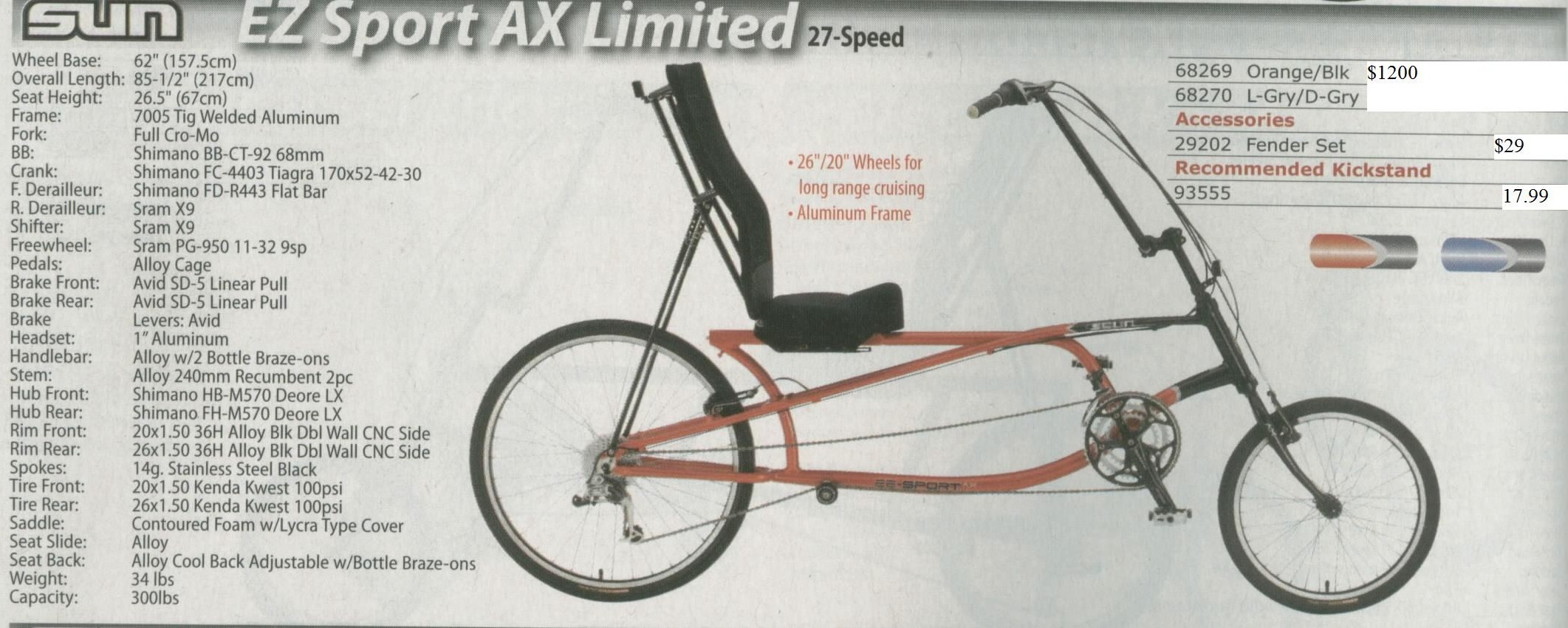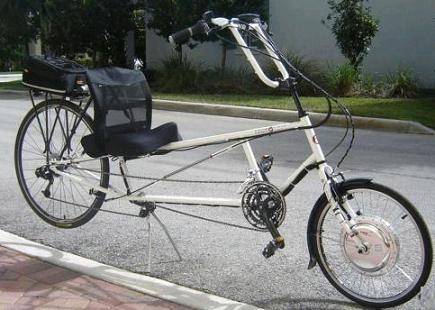imagesinthewind
100 mW
I'm Ginny in Denver, CO USA.
I have bad knees and cycling the inclines we call hills that are really mini mountains is getting
difficult. I'd like some assistance with this.
My bike is a 2011 Sun EZ Sport AX recumbent, 2 wheels.
26" rear and 20" front.
My main objectives are to have some assistance in climbing hills that can be several miles at 6-10% grades, not just powering up
the hill. I still want to do most of the work, but some assistance to stay above 7mph would be good. I currently pedal those at about 4mph and
cannot sustain over about a mile. Part of that is the shape I'm in but that's in the works, after 2 knee surgeries, I'm getting back into the swing
of cycling.
I'm not really worried about flat max speed, my bike and I are good at about 20-22 mph on flats. Recumbents geometry is not great for climbing.
My brakes are V brakes, I have a 9 speed rear cassette, 3 up front.
My bike weighs about 32 pounds, 40 with the water, Bose speaker (I don't ride silent), rack. I'm about 153ish depending on the day.
I don't know if I want a front wheel motor or rear wheel and I'm not sure on budget, I don't even know what is out there.
My husband has a Copenhagen Wheel on order, his order number says he's in the first 700 wheels to be shipped, but they have been pushing back
the shipping date for 16 months. And that is a commuter wheel and not a climbing wheel. I need something that will give me assist when I
need it going up, a little assist on flats to make up for the weight of the motor and battery. I also want the battery to last 4-7 hours.
I hope that's the info you need, I've been in contact with Paul of EM3ev and was looking at the MAC 500W/1000W Pick N Mix.
I'm totally new to this, but I work on my own cars and am pretty good with a wrench, I learn fast.
Thanks for any advice on what to get and from whom. I have an on-line friend with a Falco rear wheel on his recumbent trike (two front, one rear wheel)
and he loves it.
Thanks
Ginny in Denver
I have bad knees and cycling the inclines we call hills that are really mini mountains is getting
difficult. I'd like some assistance with this.
My bike is a 2011 Sun EZ Sport AX recumbent, 2 wheels.
26" rear and 20" front.
My main objectives are to have some assistance in climbing hills that can be several miles at 6-10% grades, not just powering up
the hill. I still want to do most of the work, but some assistance to stay above 7mph would be good. I currently pedal those at about 4mph and
cannot sustain over about a mile. Part of that is the shape I'm in but that's in the works, after 2 knee surgeries, I'm getting back into the swing
of cycling.
I'm not really worried about flat max speed, my bike and I are good at about 20-22 mph on flats. Recumbents geometry is not great for climbing.
My brakes are V brakes, I have a 9 speed rear cassette, 3 up front.
My bike weighs about 32 pounds, 40 with the water, Bose speaker (I don't ride silent), rack. I'm about 153ish depending on the day.
I don't know if I want a front wheel motor or rear wheel and I'm not sure on budget, I don't even know what is out there.
My husband has a Copenhagen Wheel on order, his order number says he's in the first 700 wheels to be shipped, but they have been pushing back
the shipping date for 16 months. And that is a commuter wheel and not a climbing wheel. I need something that will give me assist when I
need it going up, a little assist on flats to make up for the weight of the motor and battery. I also want the battery to last 4-7 hours.
I hope that's the info you need, I've been in contact with Paul of EM3ev and was looking at the MAC 500W/1000W Pick N Mix.
I'm totally new to this, but I work on my own cars and am pretty good with a wrench, I learn fast.
Thanks for any advice on what to get and from whom. I have an on-line friend with a Falco rear wheel on his recumbent trike (two front, one rear wheel)
and he loves it.
Thanks
Ginny in Denver



